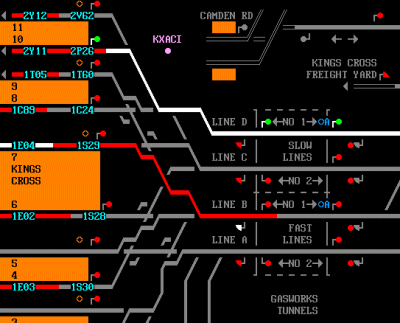The work of the signal operator or dispatcher takes place largely on the computer screen nowadays, so it should be an ideal part of railway operations to simulate. Not surprisingly, there are some very interesting and challenging examples out there. These are just a small selection.
1 siam
My personal favourite for a long time were the dos-based simulations from siam. Don’t let yourself be put off by the world’s oldest user interface (remember Turbo Pascal and ascii graphics?): these are very cleverly designed, addictive programs. Purists may disapprove, as they don’t attempt to simulate the detailed working of a signal panel, but add variety to the exercise by putting you in charge of preparing and selecting the right locos for trains, as well as controlling train and shunting movements. Most of the simulations are British-based, covering a wide range of periods, but they also do a few set in the us and continental Europe.
They will run on anything that can run dos, including Virtual pc on the Mac (they also have Amiga versions). I still play them occasionally. Main drawback: they are expensive for DOS software! Try the demos available on their site.

2 pc-Rail
The pc-Rail simulations focus more on the detail of power-box operation: you control all the individual signals on a classic nx-type panel. They are very interesting, but perhaps a little less fun than the siam simulations - I find that I don’t play them very much once I’ve learnt how to get through the timetable.
You can get additional timetables for all the simulations, and - also for a fee - a timetable editor to create your own.
3 Simsig
The authors of these programs have gone over to writing training simulators for real signallers, and are now offering the existing Simsig simulations as free downloads for private use. Like pc-Rail, they focus on realistic simulation of what the signaller actually sees, in this case on the latest iecc signal panels. A nice feature is that several of the panels incorporate Automatic Route Setting (ars) which takes care of the routine train movements, leaving you free to concentrate on dealing with problems.

4 Stanicar
This is a Czech signal simulator that includes utilities for building your own control areas and timetables. A bit like Train Dispatcher, but freeware, and with a rather better interface. It’s still under development, and the documentation is a bit patchy, but probably worth a look.
http://flint.vlaksim.com/indexEN.php

